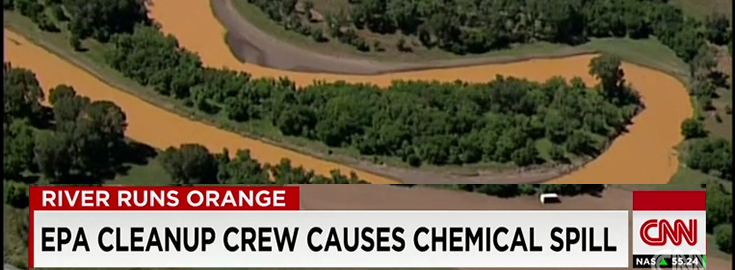EPA Crew Accidentally Spills 3 Million Gallons of Chemical Waste Water into River

Last week, the EPA accidentally spilled millions of gallons of pollutants into the Animas River in Colorado, turning the water a deep mustard-yellow and, in some places, orange. The contaminants are believed to include dissolved iron, zinc, and copper.
It’s unclear what effect the metals might have, but Colorado’s top health official said Tuesday that preliminary tests show the contamination “doesn’t appear” to present a health risk. But as CNN reported just recently, there are many unanswered questions surrounding last Wednesday’s accident.
No one is sure just how polluted the Animas River is, whether drinking water is at risk of becoming contaminated, or how the millions of gallons of pollutants might impact businesses that depend on the river for commerce.
“This is a really devastating spill,” said Kim Stevens, director of the advocacy group Environment Colorado. “We’ve been hearing from rafting companies and other businesses that rely on the river that if they can’t get clients out on the river in the next couple of days, they may have to shut down their doors.” [1]
Although a flyover by a specialized aircraft revealed that conditions on the Animas and San Juan rivers between Durango, Colorado, and Farmington, New Mexico, have improved, it has come to light that EPA scientists grossly underestimated the scope of the spill. The eco-disaster is three times bigger than originally thought. [1]

The EPA says the accident occurred when one of its teams was using heavy equipment to enter the Gold King Mine, a suspended mine near Durango. The team was tasked with entering the mine and beginning the process of pumping and treating the contaminated water inside, but accidentally caused it to flow into the nearby Animas River.
Read: Top Agribusiness Food Companies Dumping Waste in our Waters
Sampling performed by the EPA on Wednesday and Thursday at various points on the river showed levels of lead, arsenic, beryllium, cadmium and mercury were extremely high compared with acceptable levels set by the agency.
- One of the samples of mercury was nearly 10 times higher than the EPA acceptable levels.
- Samples of beryllium and cadmium were 33 times higher
- One sample of arsenic levels was more than 800 times higher.
Exposure to high levels of these metals can lead to numerous health problems, including cancer and kidney disease, as well as developmental problems in children.
“This is a real mess,” Max Costa, chair of the department of environmental medicine at New York University School of Medicine, told CNN. “These levels are shocking.” [1]
Stevens warned the rivers’ ecosystems are also at risk.
“The fish population is especially very sensitive to water contamination, and we really won’t be able to see what the impacts are until all of the pollution has run its course. Time will tell what the true impacts are,” she said. [1]
[1] CNN

Are we sure it was an accident? Not the usual false flag operation, but could be an effective one.